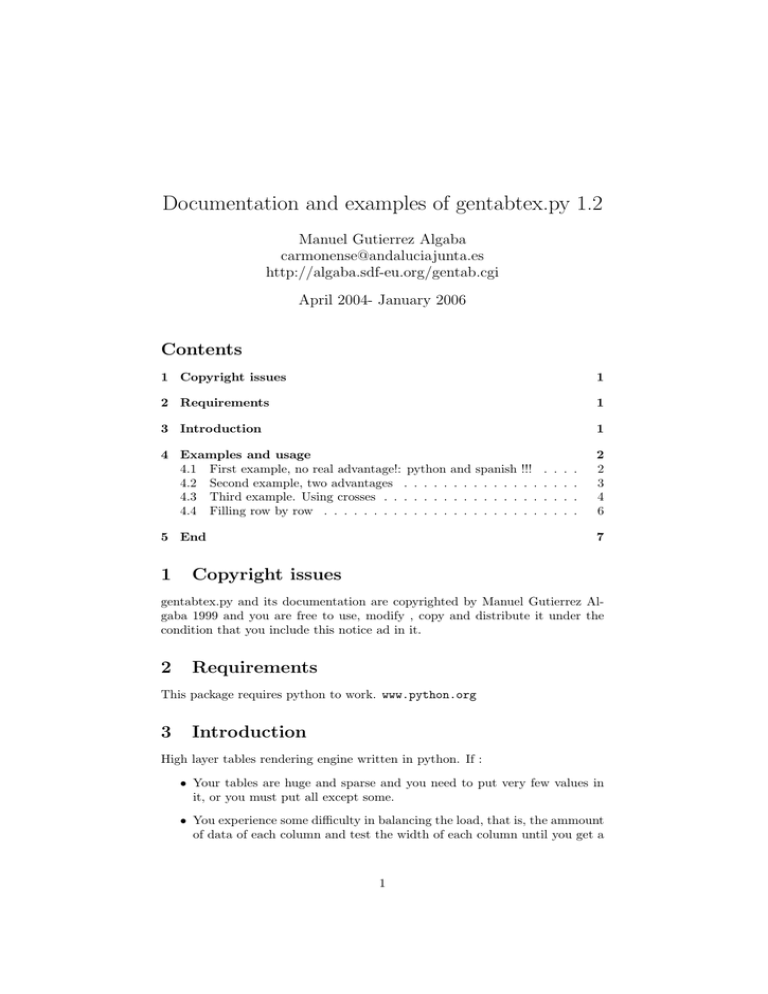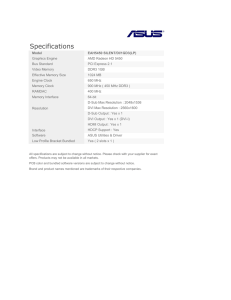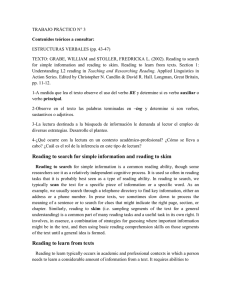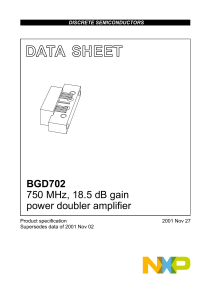Documentation and examples of gentabtex.py 1.2
Anuncio

Documentation and examples of gentabtex.py 1.2 Manuel Gutierrez Algaba [email protected] http://algaba.sdf-eu.org/gentab.cgi April 2004- January 2006 Contents 1 Copyright issues 1 2 Requirements 1 3 Introduction 1 4 Examples and usage 4.1 First example, no real advantage!: python and spanish 4.2 Second example, two advantages . . . . . . . . . . . . 4.3 Third example. Using crosses . . . . . . . . . . . . . . 4.4 Filling row by row . . . . . . . . . . . . . . . . . . . . 5 End 1 !!! . . . . . . . . . . . . . . . . . . . . . . 2 2 3 4 6 7 Copyright issues gentabtex.py and its documentation are copyrighted by Manuel Gutierrez Algaba 1999 and you are free to use, modify , copy and distribute it under the condition that you include this notice ad in it. 2 Requirements This package requires python to work. www.python.org 3 Introduction High layer tables rendering engine written in python. If : • Your tables are huge and sparse and you need to put very few values in it, or you must put all except some. • You experience some difficulty in balancing the load, that is, the ammount of data of each column and test the width of each column until you get a 1 desirable result. You don’t want narrow columns with full of data while some others are too empty and hold very few data. • You find a bit messy the notation of LATEX when dealing with tables Then this package might be for you. First of all you won’t ever need to write tables in LATEX again. You write a python programm that writes LATEX code. You place a layer between your tables and LATEX. 4 Examples and usage In my opinion the best way to learn is to see examples and experience yourself. All examples taken from the end of the very same gentabtex.py. 4.1 First example, no real advantage!: python and spanish !!! Let’s start with a rather simple example. Let’s see a broken table, a table with so huge paragraphs that they get out the paper. \begin{tabular}{lllll} colores & buen gusto & coche & gallumbos & fruta\\ rojo & es dificil conseguir algo que no sobresalte y quede bien & implica conduccion agresiva & & tomate\\ azul & los pantalones, camisas, color discreto donde los haya & es un color que como tal rara vez se da, es mas corriente en los nortes & & alga\\ verde & si no es fuerte o amerillento & no esta de moda & & melon\\ amarillo & hortero en la mayoria de las ocasiones & es el color que mejor se ve & & melon\\ \end{tabular} Ok, this is not the best way of writing a table, and you can use paragraph of fixed size and many other things. But anyway, it’s rendered thus: colores buen gusto coche rojo es dificil conseguir algo que no sobresalte y quede bien implica conduccion agresiva azul los pantalones, camisas, color discreto donde los haya es un color que como tal rara vez se verde si no es fuerte o amerillento no esta de moda amarillo hortero en la mayoria de las ocasiones es el color que mejor se ve That table can be generated using gentabtex (see the end of the code of gentabtex.py) g = gentabtex().en("rojo").en("azul").en("verde").en("amarillo"). \ cab(["colores", "buen gusto", "coche", "gallumbos", "fruta"]).otraen(1). \ en(["es dificil conseguir algo que no sobresalte y quede bien", "los pantalones, camisas, color discreto donde los haya", "si no es fuerte o amerillento", "hortero en la mayoria de las ocasiones"]).otraen(2).\ en(["implica conduccion agresiva", "es un color que como tal rara vez se da, es mas corriente en los nortes", "no esta de moda", 2 "es el color que mejor se ve"]).\ equis("ultimacolumna", ["tomate", "alga", "melon", "melon"]).\ defaspectocolumna("") g.sync() print g You can identify each element of the python programm with the latter table, you don’t really need to know python or spanish (yes, the instructions are writen spanish). Basically, that code it says that the heading (cab) is composed of “colores”, “buen gusto”, . . . . Moreover, the pairs otraen(1) and en(...) ( anotherin(number) and in(...) ) say what to put in each column, lastly, you place with equis something in the last column (ultimacolumna). Besides, you have to sync the table so it’s internally rendered and then you can get it using print g. Till now, no gain. Just some strange python code and even more strange in Spanish ! 4.2 Second example, two advantages Now, let’s see other example taken from gentabtex.py. Let’s see the four lines: g. lamatrizdispersa. calculapesos() g.repartepesos(8, 0.3) g. daaspectautoma() print g Once matrix have been synced, we can calculate weights (calculapesos) on the sparse matrix (lamatrizdispersa) and we require it to give us an “automatic aspect” (daaspectautoma, literally “give automatic aspect”), with only that we get: coloresbuen gusto rojo es dificil conseguir algo que no sobresalte y quede bien azul los pantalones, camisas, color discreto donde los haya coche implica conduccion agresiva gallumbos fruta tomate es un color que como tal rara vez se da, es mas corriente en los nortes no esta de moda melon que melon verde si no es fuerte o amerillento amarillo hortero en la mayoria de es el color las ocasiones mejor se ve Which is a huge improvement, because: alga • You have only specified the total width of the table repartepesos(8, 0.3), that’s 8 cm width with a minimum column width of 0.3 cm. 3 • If you have to resize the width, because you use package multicolumn, for example, you don’t have to worry about your tables, just specify the new width, and they’ ll get the best • If you modify your table, and add a lot of info into one column, your table will balance itself, so no column will hang full of data while the others are almost empty Still some words would require a bigger column width, perhaps using 0.5 instead of 0.3, or splitting “gallumbos” in “gallum- bos” would help. 4.3 Third example. Using crosses Some tables are like this: 0 1 2 3 4 5 6 Recorrer carpetas/Ejecutar archivo x x x x Listar carpeta/Leer datos x x x x x Atributos de lectura x x x x x Atributos extendidos de lectura x x x x x Crear archivos/Escribir datos x x x Crear carpetas/Anexar datos x x x Atributos de escritura x x x Atributos extendidos de escritura x x x Eliminar subcarpetas y archivos x Eliminar x x Permisos de lectura x x x x x x Cambiar permisos x Tomar posesin x x Sincronizar x x x x x x 1 control total 2 modificar 3 leer y ejecutar 4 listar el contenido de la carpeta 5 lectura 6 escribir That’s full of crosses, and while it’s no problem to do it manually, it’s a bit dull and error prone when the number of crosses increases. Look at the code: \begin{tabular}{lllllll} 0 & 1 & 2 & 3 & 4 & 5 & 6\\ Recorrer carpetas/Ejecutar archivo & x & x & x & x & & \\ Listar carpeta/Leer datos & x & x & x & x & x & \\ Atributos de lectura & x & x & x & x & x & \\ Atributos extendidos de lectura & x & x & x & x & x & \\ Crear archivos/Escribir datos & x & x & & & & x\\ Crear carpetas/Anexar datos & x & x & & & & x\\ Atributos de escritura & x & x & & & & x\\ Atributos extendidos de escritura & x & x & & & x & \\ Eliminar subcarpetas y archivos & x & & & & & \\ Eliminar & x & x & & & & \\ 4 Permisos de lectura & x & x & x & x & x & x\\ Cambiar permisos & x & & & & & \\ Tomar posesin & x & x & & & & \\ Sincronizar & x & x & x & x & x & x\\ \end{tabular} Just imagine dozen columns ! But if you can choose the columns by their properties, like gentabtex.py does, then: g2 = gentabtex().en(["Recorrer carpetas/Ejecutar archivo", "Listar carpeta/Leer datos", "Atributos de lectura", "Atributos extendidos de lectura", "Crear archivos/Escribir datos", "Crear carpetas/Anexar datos", "Atributos de escritura", "Atributos extendidos de escritura", "Eliminar subcarpetas y archivos", "Eliminar", "Permisos de lectura", "Cambiar permisos", "Tomar posesin", "Sincronizar"]).\ cab([0,1,2,3,4,5,6]). \ equis(1, "toda").equis(2, "todamenos", [(’c’, ’subcarpeta’), (’c’, ’Cambiar permisos’)]).\ equis("todafila", [(’c’, ’Permisos de lectura’), (’c’, ’Sincronizar’)]).\ equis(3, "desdehasta", ((’c’,"Recorrer"),(’c’, "extendidos"))).\ equis(4, "desdehasta", ((’c’,"Recorrer"),(’c’, "extendidos"))).\ equis(5, "desdehasta", ((’c’,"Listar"),(’c’, "extendidos"))).\ equis(5, "en", [(’c’,"extendidos de escritura")]).\ equis(6, "desdehasta", ((’c’,"Crear archivos"),(’c’, "Atributos de escritura"))).\ coletilla("""\\\\ 1 control total 2 modificar 3 leer y ejecutar 4 listar el contenido de la carpeta 5 lectura 6 escribir """).\ sync() Let’s see, the commands: • The first en, en(["Recorrer carpetas/Ejecut"...]) populates the first column • The cab([0,1,2...]) populates the heading 5 • Now, let’s see the first equis (equis is the spanish word for cross ), equis(1,"toda") says that all (toda) the second column will be marked • The second equis .equis(2, "todamenos", [(’c’, ’subcarpeta’), (’c’, ’Cambiar permisos’)]).\ says that the third column will be marked except (menos) those rows that contain either “subcarpeta” or “Cambiar permisos” • The equis equis("todafila", [(’c’, ’Permisos de lectura’), (’c’, ’Sincronizar’)]).\ says that all the row (fila) which contains “Permisos de lectura” or “Sincronizar” will be marked. • The equis equis(3, "desdehasta", ((’c’,"Recorrer"),(’c’, "extendidos"))).\ says that in the fourth row it will be marked those cells, starting from top, from (desde) any row containing “Recorrer” to (hasta) any row containing “extendidos” and no more will be marked, with this instruction. That’s the program starts in row 1, and compares if column 0 has “Recorrer” if not it continues, when it reaches to such column 0 storing “Recorrer” it marks in that row and in the 4th column, and it continues marking row by row at 4th column till it reaches to a row which column 0 is “extendidos” then stops marking. • Finally the equis(5, "en", [(’c’, "extendidos de escritura")]).\ places a mark (cross) into all the cells whose column is the 5th and whose row has at column0 a text containing “extendidos de escritura”. 4.4 Filling row by row Finally, we’ll see how to write a table row by row, with the advantage of selfbalancing of columns: 6 Protocolo Velocidad FrecuenciaCapacidad Categora nomibase exigible de canal al cable ble requerida 100Base- 100 12.5 12.5 Cat-3 T4 Mbps MHz MHz 802.12 100 15 15 MHz Cat-3 (VG) Mbps MHz 100Base- 100 31.25 80 MHz Cat-5 TX Mbps MHz FDDI 100 31.25 80 MHz Cat-5 (*) Mbps MHz ATM 155 77.5 100 Cat-5 (**) Mbps MHz MHz which is achieved with: tabcabtec = gentabtex().cab(["Protocolo", "Velocidad nominal", "Frecuencia base", "Capacidad exigible al cable", "Categora de cable requerida"]).\ fil([ "10Base-T", "10 Mbps", "10 MHz", "10 MHz", "Cat-3"]).\ fil(["100Base-T4", "100 Mbps", "12.5 MHz", "12.5 MHz", "Cat-3"]).\ fil(["802.12 (VG)", "100 Mbps", "15 MHz", "15 MHz", "Cat-3"]).\ fil(["100Base-TX", "100 Mbps", "31.25 MHz", "80 MHz", "Cat-5"]).\ fil(["FDDI (*)", "100 Mbps", "31.25 MHz", "80 MHz", "Cat-5"]).\ fil(["ATM (**)", "155 Mbps", "77.5 MHz", "100 MHz", "Cat-5"]).\ sync().calculapesos().repartepesos(6, 0.5). daaspectautoma() print tabcabtec I think it’s self explainatory. 5 End End. 7




